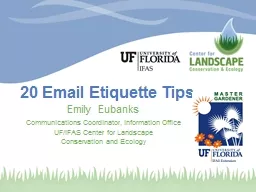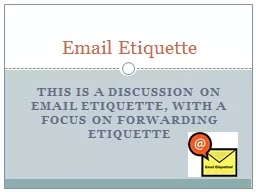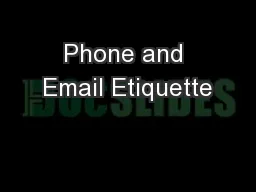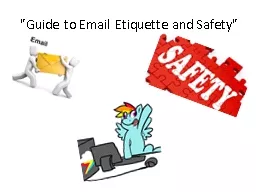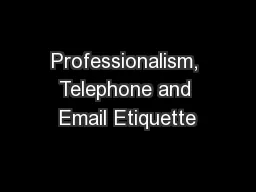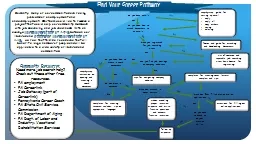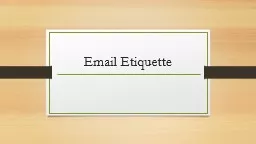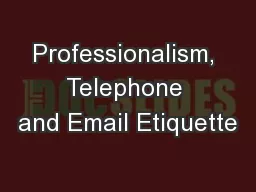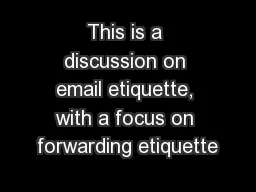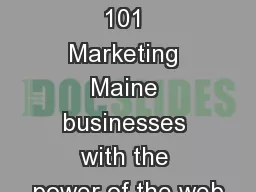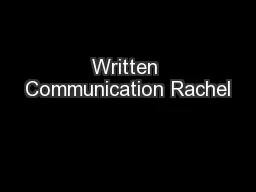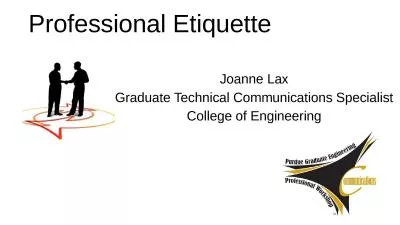PPT-20 Email Etiquette Tips
Author : luanne-stotts | Published Date : 2017-08-05
Emily Eubanks Communications Coordinator Information Office UFIFAS Center for Landscape Conservation and Ecology Why is Email Etiquette Important Printed words
Presentation Embed Code
Download Presentation
Download Presentation The PPT/PDF document "20 Email Etiquette Tips" is the property of its rightful owner. Permission is granted to download and print the materials on this website for personal, non-commercial use only, and to display it on your personal computer provided you do not modify the materials and that you retain all copyright notices contained in the materials. By downloading content from our website, you accept the terms of this agreement.
20 Email Etiquette Tips: Transcript
Emily Eubanks Communications Coordinator Information Office UFIFAS Center for Landscape Conservation and Ecology Why is Email Etiquette Important Printed words have personality That personality makes positive and negative impressions on us. Design. Topic 11. Purpose of a Website. Website Etiquette. Website Organization. Hyperlinks. Plagiarism. Bad Websites. References. Content. A webpage has to offer something to the viewer. More than pretty colors, pictures, etc. Email Etiquette . What is . etiquette. ?. The rules which indicate the “correct” way to behave in a certain time and place.. Email etiquette is especially important in the work place . 5 Basic Email Etiquette Rules. What You Should Know Before You Hit Send. Phone and Email . Etiquette. Etiquette Basics. Know your audience. Choose an appropriate tone. Do not be overly familiar with those you don’t know well. Always identify yourself. . What a student should do if he/she receives an email with a flame, spam, or hoax?. He/she shouldn't open . it they should leave it alone . . . . What a student should do if he/she feels uncomfortable about an email from a friend with an attachment?. Presenter. Nicole Brantley. City of Savannah. Professionalism. What is it?. Who . is it expected from?. How is it measured?. Why bother?. Professionalism . What is it?. The . skill, good judgment and polite behavior that is expected from a person who is trained to do a job well.. Yes. No. Do you know how to attach documents to an email?. Yes. No. Have you registered for job searching sites?. Yes. No. Photos and guide for attaching and downloading documents.. List of common and reputable job searching sites, basic how-to for registering.. Cambridge Nationals R001. What is email?. Email is short for 'electronic mail'. I. t . is sent via the internet to a recipient. . An . email address is required to receive email, and that address is unique to the user. . Do Now (video 3 minutes). https://www.playposit.com/delivery/100495/445331/emails. Email Tips. Email is FOREVER. Once you send it off, you can't get it back. Once your professor or teacher has it, he or she owns it and can save it or, in the worst case, forward it onto colleagues for a good laugh—at your expense.. Presenter. Nicole Brantley. City of Savannah. Professionalism. What is it?. Who . is it expected from?. How is it measured?. Why bother?. Professionalism . What is it?. The . skill, good judgment and polite behavior that is expected from a person who is trained to do a job well.. Email Etiquette . What is . etiquette. ?. The rules which indicate the “correct” way to behave in a certain time and place.. Email etiquette is especially important in the work place . 5 Basic Email Etiquette Rules. Marc A. Pitman, The Fundraising . Coach . www.FundraisingCoach.com. Brochures . Web 2.0 User Generated Content. A Brief History. Start small. Your Google Profile. Your Personal . Google Profile. evans. , . maricopa. county sheriff’s office. director, business information systems & digital communications. Topics. Email etiquette. Business reports. Sharing data. Email Etiquette. signature block . Email Etiquette How to email someone and get what you want! When you email someone, you present yourself to them, often for the first time You need to pay close attention to your TONE, as well as a few rules: Graduate Technical Communications Specialist. College of Engineering. Etiquette Presentation Overview. What is etiquette and why should you care?. How does it affect the job search process?. Where does it come into play?.
Download Document
Here is the link to download the presentation.
"20 Email Etiquette Tips"The content belongs to its owner. You may download and print it for personal use, without modification, and keep all copyright notices. By downloading, you agree to these terms.
Related Documents

